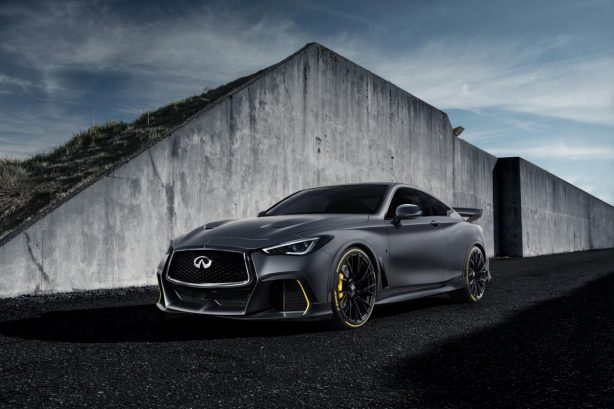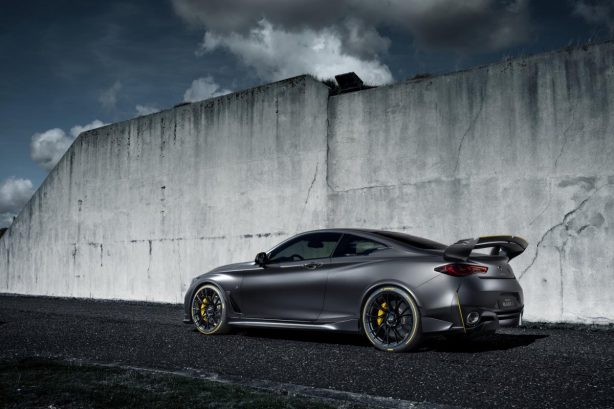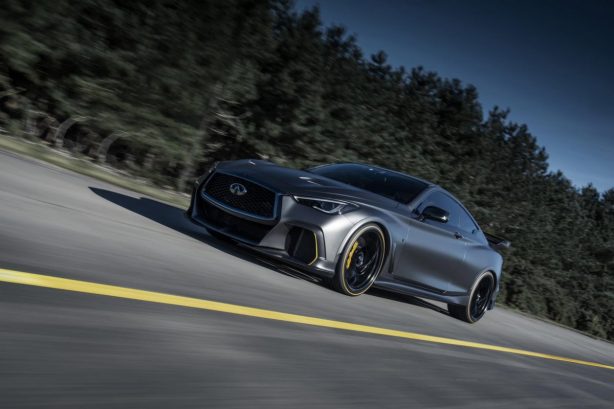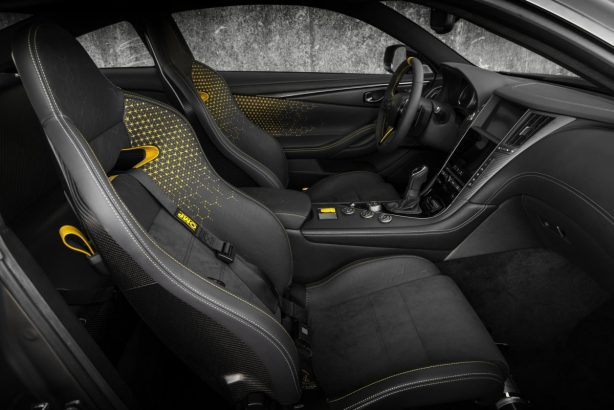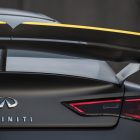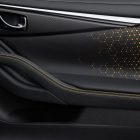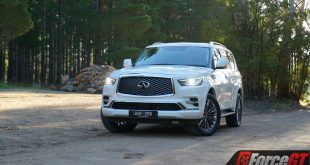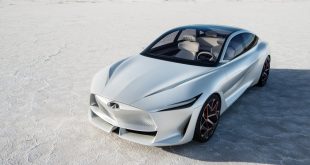Infiniti’s radical Project Black S prototype has been officially revealed this week.
Based on the road-going Q60 Red Sport 400 coupe, the prototype is a follow-up to the concept car first shown in 2017 at the Geneva Motor Show that now sports a Formula One derived “dual-hybrid” drivetrain.
The test-bed Q60 fuses the dual-hybrid technology with the production car’s 3.0-litre V6 twin-turbo engine.
Where the conventional V6 engine produces 298kW, the F1 style ‘energy recovery system’ (ERS) dual-hybrid system brings an additional 122kW to lift total output to a potent 420kW.
The prototype’s powertrain employs three motor generator units (MGU). A single MGU-K unit (‘K’ stands for ‘kinetic’) harvests kinetic energy from braking, while two MGU-H units (‘H’ for ‘heat’) harvest heat energy from exhaust gases that spin up the twin turbos.
Electrical energy harvested by the three MGUs is stored in a 4.4kWh lithium-ion battery pack, located in the rear compartment.
As in a Formula One car, the power recovered by the MGUs and stored in the battery pack is deployed in two ways.
Firstly, it acts as an electrically-assisted anti-lag system, spooling up the turbine blades within both e-turbos more quickly and rapidly.
Secondly, energy stored in the battery can be used to power the MGU-K, feeding up to 120 kW of additional electric power directly into the drivetrain.
As a result, the dual-hybrid technology enables a much stronger acceleration that is instantaneous and lag-free.
In the development prototype, the extra electric power is applied to the rear axle through a newly-designed final drive assembly on the rear axle, which integrates the MGU-K.
The prototype is also the first Infiniti vehicle with full ‘by-wire’ driver controls.
Alongside drive-by-wire and gear shifts, as well as Infiniti’s steer-by-wire system, the Q60 Project Black S features a new brake-by-wire (BBW) regenerative braking system.
Optimised for track and road use, the new braking system replaces the Q60 Red Sport 400’s standard brakes (355mm front and 350mm rear ventilated iron disc brakes) with new 380mm and 360mm carbon-ceramic drilled and ventilated brakes.
A legalised feature of Formula One cars since 2014, the BBW system is said to be a better match for the Q60 Project Black S prototype’s new powertrain packaging, compared to the donor car’s standard brakes.
The adoption of the MGU-H and MGU-K units necessitates increased powertrain cooling, and the solution is the creation of wider cooling ducts in the front bumper, two outlets in the bonnet to draw heat away from the turbochargers and MGU-H units, and aerodynamics which contribute to cooling the MGU-K situated behind the rear axle.
With 420 kW – 41 per cent more than the Q60 Red Sport 400 – the prototype can accelerate from 0 to 100 kph in under four seconds.
With the battery pack sufficiently charged, the MGU-K system, taking advantage of the low-down torque of the electric motor, can also provide an electrically-assisted launch control for maximum acceleration from a standstill.
On track, Infiniti says the Project Black S can provide sustained and sustainable hybrid performance, delivering “devastating” electrically-assisted acceleration, lap after lap after lap.
The Project Black S prototype stores this energy and discharges it as the driver requires, spooling up the turbochargers instantaneously as the driver opens the throttle, and boosting power sent to the rear wheels via the MGU-K over continued periods of acceleration.
The prototype offers drivers with three Formula One-inspired drive modes: ‘Road’, ‘Quali’ and ‘Race’. Each alters the way in which the powertrain gathers and discharges energy.
‘Road’ mode offers the most flexible and efficient use of electric power, for use in conventional driving conditions.
It recharges the battery on-the-go with low-level, non-invasive energy recovery, while ensuring the driver can still call upon a quick burst of acceleration to overtake another vehicle or gather speed when joining a highway.
‘Quali’ Mode offers ultimate on-track performance, deploying as much power as possible under acceleration and enabling the prototype to carry on building speed, even on longer straights.
In this mode, the prototype harvests more kinetic energy under heavy braking as the driver approaches a corner (compared to Road mode, where the increased kinetic braking effect would negatively impact the driver’s ability to drive smoothly).
Accelerating away from the turn, the battery then discharges energy to help the car gather speed quickly, even as the MGU-H continues to recover heat energy.
‘Race’ mode is designed to offer a sustained deployment of energy for use on the track.
In this mode, in contrast to ‘Quali’ mode, the prototype releases energy under acceleration where its deployment can maximise on-track performance or lap times, and saves energy elsewhere if needed.
Celebrating the partnership with the Renault Sport Formula One Team, the prototype is finished inside and out in black with yellow highlights – inspired by the famous livery of the team’s Formula One cars.
The Q60 Red Sport 400’s 20-inch aluminium alloy wheels have been replaced by new 21-inch forged aluminium wheels (275/30 R21 at the front, 295/30 R21 at the rear). Wheels are shod in high-performance Pirelli P ZERO road tyres.
To save weight. the steel bonnet, boot lid, fenders and roof of the standard car have been replaced with lighter carbon fibre panels.
The pared-back interior, still recognisably based on that of the Q60 donor car, also benefits from a ‘lightweighting’ approach, with features and functions evoking the minimalist operability of a Formula One car.
The Infiniti Project Black S will be officially unwrapped at the upcoming 2018 Paris Motor Show.
Powertrain
Prototype 3.0-litre ‘VR30’ twin-turbo dual-hybrid V6 petrol
Type Twin-turbocharged with dual-hybrid energy recovery system (ERS)
Displacement (cc): 2,997
Bore and stroke: 86.0 x 86.0 mm
Cylinder angle: 60 degree
Cylinder layout: V6
Max power (engine): 298 kW @ 6,400 rpm
Max torque (engine): 475 Nm @ 1,600-5,200 rpm
Electric Drive
ERS MGU-K (1), MGU-H (2)
Motor generator unit – kinetic (MGU-K)
Type AC permanent magnet synchronous motor
Max power: 120 kW
Motor generator unit – heat (MGU-K)
Type AC permanent magnet synchronous motor, split-turbo
Max power: 30 kW
Battery
Type Lithium-ion polymer
Energy: 4.4 kWh
Power: 120 kW
Total powertrain output
Max power: 420 kW
Max torque: TBC
Transmission
Seven-speed automatic
Drivetrain
Rear-wheel drive
Performance targets
0-to-100 kph <4.0 seconds
Top speed TBC
Suspension and damping
Front Fully-independent subframe-mounted double wishbone suspension, coil springs and gas-filled shock absorbers, with anti-roll stabiliser bar
Rear Fully-independent subframe-mounted multi-link suspension, coil springs and gas-filled shock absorbers, with anti-roll stabiliser bar
Steering
Type Direct Adaptive Steering, steer-by-wire, variable ratio
Brakes
Front 380 mm, carbon-ceramic, drilled and ventilated
Rear 360 mm, carbon-ceramic, drilled and ventilated
Wheels and tires
Front 275 / 30 R21, forged aluminium
Type 295 / 30 R21, forged aluminium
Weight
Curb weight 1,775 kg
 ForceGT.com Car News, Car Reviews, Video Reviews, Tuning and much more.
ForceGT.com Car News, Car Reviews, Video Reviews, Tuning and much more. 